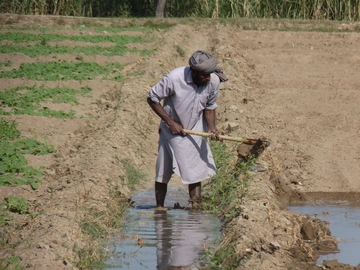Improving irrigation efficiency and productivity in Pakistan
April 05, 2023.
Pakistan depends on irrigation-based agriculture. This doctoral research looked into options for making irrigation systems more efficient in the face of 'old' challenges such as water scarcity and 'newer' ones such as the impact of climate change.
Irrigated agriculture is by far the major consumer of surface- and groundwater in Pakistan, accounting for nearly 95% of the country’s water withdrawals. Surface water is distributed to farmers according to the so called Warabandi principle. The century-old Warabandi system allocates water to farmers in seven-day terms in compliance with a predetermined timetable specifying the day, time and amount of water supply, proportional to the size of the respective famer’s land. Warabandi aims not only to maintain an equitable distribution of surface water to farmers, but also to cope with water scarcity by efficiently irrigating as much land as possible with the limited amount of surface water available.
Problems and opportunities in Pakistan’s water distribution system
The Warabandi system is relatively easy to run and managed by public authorities, its operation therewith transparent. But, on the downside, it is inflexible which makes it difficult to address the day-to-day challenges of water distribution. It does not compensate users at the lower reaches of the canals for decreased water supplies caused by conveyance losses along the canals. Besides, it is a rigid supply-based irrigation mode that does not match the time-depending demand of crops. Moreover, Warabandi does not take soil features and an increasingly variable environment caused by climate change into account.
Research in Punjab
This research was conducted in the area of the Mungi distributary canal, located in Punjab, Pakistan. The area is dominated by irrigated cotton cultivation. The researcher’s objective was to look for alternative and
more flexible options for improving irrigation at farm level within the given context of the large-scale water allocation system of Warabandi. Extensive fieldwork was conducted in the study area in 2019 and 2020. The field research assessed current irrigation practices and derived options to improve irrigation efficiency and increase productivity through advancing irrigation scheduling.
On-farm water management package
The most promising way to achieve higher water productivity at farm level (bottom-up approach) proved to be by integrating interventions into a package for on-farm water management. This package combines: (i) Providing demand-oriented irrigation schedules, (ii) Advancing irrigation schedules by sensor-based soil moisture monitoring,which can unfold its potential by (iii) Establishing a storage option of Warabandi allowance during the potential surplus time in a pond to create an enabling environment for demand-based irrigation. Furthermore, by (iv) Using the drip method, irrigation efficiency could be increased and the undersupply situation in Warabandi-guided irrigation schemes reduced.
Conclusion
This research provides detailed information on the actual irrigation practices of cotton cultivated in the Punjab area. Its results provide information about options for advancing on-farm water management interventions to policy makers, irrigation managers, academics, private sector employees, and farmers. The research has therefore the potential to contribute to a sustainable and productive transformation of cotton farming in Punjab and beyond.
Imran Sajid defended his doctoral thesis successfully in November 2022 and obtained his doctoral degree from the Agricultural Faculty of Bonn University.
Watch a video about Imran's doctoral research on ZEF's youtube channel: https://www.youtube.com/watch?v=BNpPb5s9ExU
Author: Imran Sajid conducted and completed his PhD research at ZEF.
Contact: i.sajid(at)uni-bonn.de
This article was published in ZEF News No. 46.


